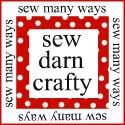Continuing the Crochet theme, below you will see a handy reference chart which should help you in working the different crochet stitches properly. When I haven't crocheted in a while, sometimes I forget how many stitches to add to the beginning chain for the stitch I want to use, or how many chains to work before turning, or if I am supposed to start the next row in the first or second stitch. If you are making up a design as you go along instead of working from a pattern which would give you this information, sometimes it's hard to remember the details of each stitch. So here is all that information and more in a handy reference chart.
The first column -- # times to wrap yarn -- tells the number of times to wrap the yarn around the hook when beginning the stitch and before putting the hook into the stitch or chain below.
The second column -- YO, pull thru # loops # times -- refers to the number of times you need to Yarn Over and pull the yarn through the number of loops to form the stitch. This is after you initially Yarn Over and pull the yarn through the stitch or chain below.
The third column -- chain plus # -- gives you the number of chain stitches you have to add to the beginning chain in order to work that particular stitch. For example, if you want to work a piece in double crochet that will be 30 stitches wide, you would chain 30 then add 3 more chains before turning and working the first row of double crochet stitches.
The fourth column -- insert hook in # chain from hook -- refers to which chain stitch you insert your hook into after working the beginning chain and turning to begin the first row of stitches. In the example above, you would insert your hook in the 4th chain from your hook.
The fifth column -- chain # to turn -- gives you the number of chain stitches to work at the end of a row before you turn to begin the next row of the particular stitch. For example, if you are going to work triple crochet for your next row, you would chain 4 before turning.
The sixth column -- insert hook in this stitch to start new row -- tells you which stitch to put your hook into when you start a new row of the particular stitch. For example, if you are working a row of half double crochet stitches, you would first chain 2 to turn then insert your hook in the 1st stitch to begin the next row.
The last column -- use turning chain as stitch? -- tells you whether or not the turning chain will be considered a stitch. If you notice that for both single crochet and half double crochet stitches, the first stitch in a row is worked into the first stitch of the row below and the turning chain is not counted as a stitch, but in all others the first stitch is worked in the second stitch of the row below and the turning chain is counted as a stitch. This keeps the stitch count consistent throughout your work. This is the rule, but some patterns will indicate not to use the turning chain as a stitch in which case you simply follow the directions as given for the pattern.
I hope you will find this chart helpful when working your crochet projects. You might want to bookmark this page so you can find it quickly.
Happy Stitching!

Click here to return to HookedOnNeedles.com
| # times to wrap yarn | YO, pull thru # loops, # of times | Chain plus # | Insert hook in # chain from hook | Chain # to turn | Insert hook in this stitch to start new row | Use turning chain as stitch? | |
| Single | 0 | 2, 1x | 1 | 2nd | 1 | 1st | no |
| Half Double | 1 | 3, 1x | 2 | 3rd | 2 | 1st | no |
| Double | 1 | 2, 2x | 3 | 4th | 3 | 2nd | yes |
| Triple | 2 | 2, 3x | 4 | 5th | 4 | 2nd | yes |
| DoubleTriple | 3 | 2, 4x | 5 | 6th | 5 | 2nd | yes |
| Triple Triple | 4 | 2, 5x | 6 | 7th | 6 | 2nd | yes |
The first column -- # times to wrap yarn -- tells the number of times to wrap the yarn around the hook when beginning the stitch and before putting the hook into the stitch or chain below.
The second column -- YO, pull thru # loops # times -- refers to the number of times you need to Yarn Over and pull the yarn through the number of loops to form the stitch. This is after you initially Yarn Over and pull the yarn through the stitch or chain below.
The third column -- chain plus # -- gives you the number of chain stitches you have to add to the beginning chain in order to work that particular stitch. For example, if you want to work a piece in double crochet that will be 30 stitches wide, you would chain 30 then add 3 more chains before turning and working the first row of double crochet stitches.
The fourth column -- insert hook in # chain from hook -- refers to which chain stitch you insert your hook into after working the beginning chain and turning to begin the first row of stitches. In the example above, you would insert your hook in the 4th chain from your hook.
The fifth column -- chain # to turn -- gives you the number of chain stitches to work at the end of a row before you turn to begin the next row of the particular stitch. For example, if you are going to work triple crochet for your next row, you would chain 4 before turning.
The sixth column -- insert hook in this stitch to start new row -- tells you which stitch to put your hook into when you start a new row of the particular stitch. For example, if you are working a row of half double crochet stitches, you would first chain 2 to turn then insert your hook in the 1st stitch to begin the next row.
The last column -- use turning chain as stitch? -- tells you whether or not the turning chain will be considered a stitch. If you notice that for both single crochet and half double crochet stitches, the first stitch in a row is worked into the first stitch of the row below and the turning chain is not counted as a stitch, but in all others the first stitch is worked in the second stitch of the row below and the turning chain is counted as a stitch. This keeps the stitch count consistent throughout your work. This is the rule, but some patterns will indicate not to use the turning chain as a stitch in which case you simply follow the directions as given for the pattern.
I hope you will find this chart helpful when working your crochet projects. You might want to bookmark this page so you can find it quickly.
Happy Stitching!

Click here to return to HookedOnNeedles.com
Labels: crochet hints, double crochet, half double crochet, handy helper, helpful hints, learn to crochet, single crochet, triple crochet








3 Comments:
Wow, this is a great thing to have! You hit on exactly what I needed to know. Thanks Mary Grace. I saved it to Word so I can bring it up again, but I also printed it for my crochet bag. I'm so excited to start work on my blanket again!
By Anonymous, At
September 24, 2008 at 6:44 PM
Anonymous, At
September 24, 2008 at 6:44 PM
Brilliant post. I can't thank you enough.
By Anonymous, At
October 1, 2015 at 9:30 PM
Anonymous, At
October 1, 2015 at 9:30 PM
You're most welcome, Anonymous! I am so glad you find it helpful!
MGM
By Mary Grace McNamara, At
October 1, 2015 at 10:10 PM
Mary Grace McNamara, At
October 1, 2015 at 10:10 PM
Post a Comment
Subscribe to Post Comments [Atom]
<< Home